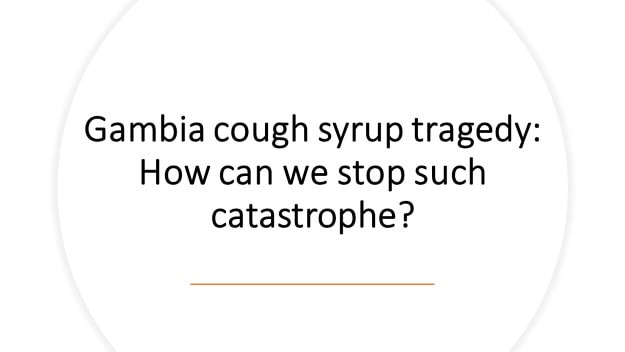Diethylene glycol and ethylene glycol are known toxic items and are ‘source-related’ impurities of the solvent used in the cough formulation. At the outset, for those new to this topic, let me briefly explain what is meant by ‘source- related’ impurities- There are broadly two types of impurities in drug products- (1) Source-related impurity and (2) Impurities arising as a result of product manufacturing and/or generated during the shelf-life of a product. These impurities are referred to as degradation products.
The source-related impurities are traces of substances in the raw material in lieu of its manufacturing. These source-related impurities cannot be totally avoided but must be controlled and must be within permissible limits mandated in the pharmacopoeia. Further, these source-related impurities must be within acceptable limits in the finished formulation (whenever that raw material is used) at all times until after the expiration of that finished formulation.
Same goes for the degradation products, they too (if present) must be within limits stated in the product monograph. If the impurity levels get higher than accepted limits, it can cause minor to critical safety concerns.
Coming back to this unfortunate incident…
Deaths linked to diethylene glycol from cough syrup was first reported in the year 1937 in the United States, the ill-famous ‘Elixir Tragedy’.
Since that incident, regulators and pharma companies worldwide have put in stringent cGMP (current good manufacturing practices) criteria in drug product development thru manufacturing as well as post-marketing surveillance. The fundamental objective of cGMP is to ensure quality, efficacy and safety in drug product at all times until after its expiration. An incident such as this one, prima facie means a break-off from the norms i.e. non-compliance to the cGMP process.
Also, cGMP does not mean ‘best practices’ implemented only during manufacturing. cGMP is a wide-spectrum best practice and is applicable to all upstream and downstream processes of a product’s lifecycle. Non-compliance in adhering to these ‘best practices’ at any stage of the upstream and/or downstream processes can lead to mishaps, even fatalities.
So, what happened in this case? Why so many people died after taking a cough syrup? Why did the syrups have unacceptable quantities of diethylene glycol in them? As a member of the pharma fraternity such questions came my way (from friends and acquaintances) for the past few days. Since this matter is under investigation by competent authorities, we'll know in the coming days. But our objective as responsible pharma professionals, is not to just find out what happened in this unfortunate case, but also proactively ensure that such situations do not happen in the future.
In fact, I shall say- selling a safe product to the consumer is the seller’s prime responsibility, no two ways about it. Hence, not just drug products, but all products must have the desired quality attributes and must be safe in the hands of the user. But how can companies ensure this?
There are several ways to achieve this. But the surest and fastest route is to- Start implementing QbD (quality-by-design) in the product’s value chain, and mistake-proof all processes in the product’s supply chain.
Mistake-proofing means you don’t leave any scope for errors to happen while working the process. For example, try putting a two-pin or a three-pin plug into a socket. It won’t fit-in unless inserted the right way. Another example of process mistake-proofing is a washing machine. If you were to flip open a washer’s door while it was running its cycle, the machine immediately stops. But the moment you shut back the door it re-starts! Such mistake-proofing with a plug's or washer's design and operation is to prevent accidents i.e. consumer safety.
Pharma companies must couple cGMP with mistake-proofing; that is, apply appropriate error-proofing measures to all its technical and business processes.
Some of the promising and time-tested error-proofing tools are Poka Yoke, FMEA, Visual Management, CAPA etc. I’ve separate posts on Poka Yoke and Visual Management, do check them out …
- Improve Process Efficiency with Visual Management
- Mistake-Proofing Pharmaceutical Product Development, Manufacturing and Logistics, Cost Savings via Poka Yoke
- Mistake-Proofing Pharmaceutical Products: What can we learn from Valsartan, Losartan and Irbesartan recalls?
- Valsartan, Irbesartan, Losartan Product Recalls- What are the Lessons for Pharmaceutical Industry?
News update- Subsequently, a report in India's one of the leading newspaper Economic Times stated that the Medicines Control Agency MCA and The Gambian drug regulatory authorities have not yet found definitive links between the deaths and the cough syrup, and that the cause of child deaths is still unknown.
Follow Shruti on Twitter, Facebook, YouTube, LinkedIn
Categories: Life Sciences | Mistake-Proofing
Keywords and Tags:
#Gambiatragedy #coughsyruplinkeddeaths #diethyleneglycol #mistakeproofingprocesses #cGMP #PokaYoke #FMEA #VisualManagement #GambiaChildDeaths





















